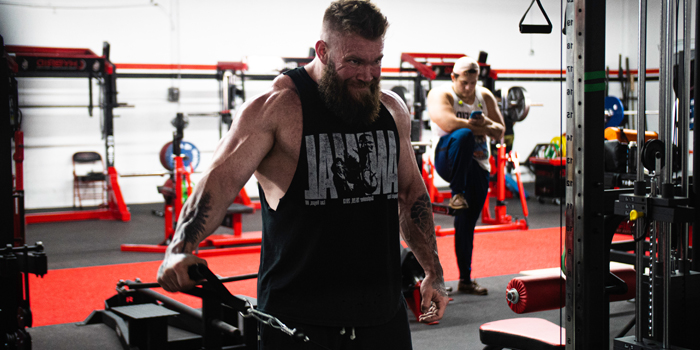
There is nothing quite like imposing assets of cannonballs hanging off the sides of your AC joints. Whether or not it’s the X-frame freak factor physique of the 1k-total powerlifter, massive delts pack a visual punch and help to maintain the overall health of the shoulder as well.
Their simple structure makes them relatively easy to train, as they, unlike biceps and triceps, cross only one joint. The three heads of the deltoid (anterior, medial, posterior) encapsulate the glenohumeral joint and are often trained by three separate movements.
- Dumbbell front raises for the anterior delts
- Dumbbell lateral raises for the medial delts
- Dumbbell and rear delt flys for the read delts
Nothing to it.
Right?
Well… I’m not going to say that dumbbell laterals don’t “work,” but at some point, we might want to consider spicing up our delt training with a little variety, ditching the dumbbells, and opting for cables.
I’m not asking you to turn in your manhood. Just hear me out.
As discussed in previous articles, muscles have a varied ability to exert force at various lengths. This is to say that when a muscle is in its lengthened and shortened positions, it is less capable of handling heavyweights. Meanwhile, in the middle part of a muscle range lies its greatest ability to exert force.
RECENT: Science is the New Religion
When we look to apply these principles of length and tension to the deltoid, we need to make one distinction. There is a difference between the range of motion of a muscle and the range of motion of a joint.
So, let’s look at the arch of the abduction of the shoulder. From our arms at our sides to the full abducted position, we use different muscles at different times to achieve this large, sweeping arch.
- 0-20 degrees: Supraspinatus
- 20-110 degrees: Deltoid
- 110-180 degrees: Lower/middle trap
So, for our purposes in delt training, we are really concerned only with loaded degrees of abduction from 20-110 degrees. This means that our deltoid is long at 20 degrees (weak), mid-range at 65 degrees (strong), and short at 110 degrees (weak).
Now, let’s consider how dumbbells would exert their force against the deltoid through this arch.
As we begin, the dumbbell is pulling toward the center of the earth, applying minimal force to the deltoid (or supraspinatus), and applying most of its force through the fibers of the upper trap. As we begin to travel outward through the arch, the deltoid becomes matched with increasing amounts of downward force by the dumbbell, but the problem lies as we finish the movement.
The dumbbell is applying its greatest amount of downward force during the part of the arch where our delt becomes weak again. This mismatch of the strength curve of the deltoid and the resistance profile of the dumbbell leave much to be desired when it comes to creating effective tension.

Enter…The Cable Lateral Raise
The cable side lateral raise mitigates this mismatch and can create a more harmonious profile for the strength curve of the deltoid. It allows us to drive more stress and to turnover more reps, which will ultimately lead to more stimulus and hopefully adaptation.
Again, I’m not saying to ditch the dumbbell all together. You can make a sophisticated argument that the dumbbell lateral allows us to integrate the function of the deltoid. After all, the deltoid group creates what’s called glenohumeral superior translation, which can be beneficial for maintaining shoulder function. Just sprinkling in cable lateral raises can help to keep the applied force down and the stimulus high to really drive headfirst toward our goal of achieving massive delts.
Conclusion
If dumbbells have been defacto in your delt training, perhaps it’s time that we swap them out for the cable lateral. As a broader takeaway, we should always be considering lines of pull, fiber orientations, strength curves, and resistance profiles when selecting, setting up for, and executing movement in a program.
To a certain extent, everything works, but nothing works every time.
Stay strong,
Jordan











3 Comments